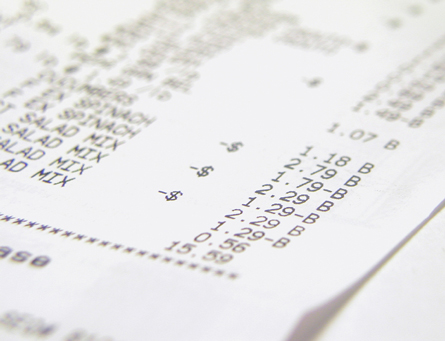More evidence that BPA laces store receipts
Problem is, you can't tell which ones host the hormone mimic.
People interested in limiting exposure to bisphenol A — a hormone-mimicking environmental contaminant — might want to consider wearing gloves the next time a store clerk hands over a cash-register receipt. A July 27 report by a public-interest research group has now confirmed many of these receipts have a BPA-rich powdery residue on their surface. But you can’t tell which ones on the basis of a visual inspection.
A building block of polycarbonate plastics, bisphenol A is also a biologically active estrogen mimic. Less well known, many thermal- and carbonless-copy papers also employ BPA to print images, generally store receipts.
In animals, fetal exposures to BPA can be especially risky, sometimes fostering brain, behavioral or reproductive problems. Canada and some states are moving to ban polycarbonate plastic in baby bottles for that reason. And heart data suggest that even adult exposures to BPA might cause harm.

A vexing question has been where people are acquiring the BPA that taints nearly everyone’s body. Last year, green chemist John Warner argued that his data suggested store receipts could be a — if not the — leading source.
In its own quest to gauge the prevalence of BPA in store receipts, the Washington, D.C.-based Environmental Working Group, or EWG, recently commissioned University of Missouri scientists to assay for the chemical in 36 receipts that it had collected from banks, grocery stores and other retailers in the District and seven states (running from Connecticut and Maryland to California and Oregon).
The receipts came from purchases made at places including Safeway, Whole Foods, CVS, Walmart, Chevron, McDonald’s, the U.S. Postal Service and cafeterias in the House of Representatives and U.S. Senate. They also included three fast-food franchises (Starbucks, Kentucky Fried Chicken and McDonald’s) located in Japan.
Chemical analyses turned up BPA on all but seven receipts. Sixteen hosted substantial quantities, averaging 1.9 percent BPA by weight of a receipt (and ranging from 0.8 to 2.8 percent).
“The receipt for a McDonald’s Happy Meal™ purchased in Clinton, Conn., on April 21, 2010, had an estimated 13 milligrams of BPA,” EWG notes online in a summary of its findings. “That equals the amount of BPA in 126 cans of Chef Boyardee Overstuffed Beef Ravioli in Hearty Tomato & Meat Sauce,” the group points out — “one of the products with the highest concentrations of BPA in EWG’s 2007 tests of canned foods.” A receipt from the McDonald’s in Japan, however, had nondetectable concentrations of BPA.
Safeway “had the highest levels by several measures,” EWG reports. This supermarket’s receipts “had 3 of the top 6 highest overall BPA levels,” it found. A Safeway in the nation’s capital “had the greatest total estimated mass of BPA (41 milligrams),” and a Berkeley, Calif., Safeway had the peak BPA value by mass, with the chemical accounting for 2.8 percent of the receipt’s weight. One of two Whole Foods supermarkets also issued receipts with substantial BPA; the other’s receipt was virtually BPA-free.
Overall, 40 percent of the collected receipts hosted high concentrations of BPA. Many other retail outlets issued receipts having only about one-hundredth as much of the chemical.
Why the difference? Those with low levels of contamination “would seem consistent with potentially recycled paper,” explains Dave Andrews, an EWG staff chemist. Indeed, 7 years ago I reported data presented at a European conference indicating that BPA from thermal paper was making it into recycled goods — in that case, toilet paper. Concern about such cross contamination of BPA from thermal paper has prompted EWG to recommend that consumers trash store receipts instead of recycling them.
Interestingly, as a class, only ATMs — all three of which had been hosted by Bank of America — issued receipts with nondetectable BPA concentrations in the EWG survey. Target stores in the three states monitored and two of the three Walmarts surveyed also issued paper receipts with nondetectable or nearly nondetectable BPA values.
The mere presence of BPA in paper does not necessarily mean it will end up in people. Which is why EWG did a damp wipe of four receipts to see how much could be removed. And between 0.7 and 3.8 percent of the BPA “easily wiped off,” reports Andrews. “That’s a direct concern for me,” he quips, “because I generally have sweaty hands.”
The damp swipe might also simulate a toddler with slobbery hands that plays with the receipt or acquires some of the sloughed off BPA from the hand of a parent that just paid for that Happy Meal.
Bill Van Den Brandt of Appleton Papers says that the receipts paper made by his company (which bills itself as the nation’s leading producer of carbonless and thermal papers) is BPA-free. Which would be useful for a consumer to know if the company’s name was also printed on that paper. It isn’t.
Actually, Appleton and other BPA-free paper makers should look at EWG’s new data as a marketing opportunity.
For instance, how about imprinting a running line on the front edge or back side of receipt paper that says BPA-free? This would — at the point of sale — alert consumers who are wary of BPA exposures that the sales receipt they’ve just been handed will not add to their bodies’ accumulation of the chemical.






